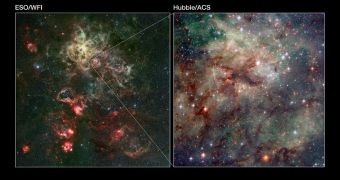Using the Hubble Space Telescope, a team of experts managed to get the most detailed view to date of the insides of the Tarantula Nebula, one of the most beautiful such structures in the known Universe.
This outstanding feature is located in our neighboring galaxy, the Large Magellanic Cloud, and can be seen with amateur telescopes relatively easily. In essence, it is nothing but a massive stellar factory, producing stars at high rates.
Experts say that this is one of the main reasons why it looks so astonishing. The vast amounts of hydrogen gas and cosmic dust permeating the entire area are constantly being battered by massive volumes of radiation from blue stars.
The gas therefore starts emitting light at various wavelengths, which makes it look very good in Hubble's sensitive eyes. Ionized gas is a common trademark of several nebulae, all of which are considered to be beautiful as far as space structures go.
The tendrils of dust and gas that can be seen in the new image are what gave the nebula its original name, because astronomers interpreted them as resembling spindly spider legs. These filaments were most likely produced by recent supernova explosions, experts say.
In order to snap this view, astronomers used the Hubble Advanced Camera for Surveys (ACS), a tremendously capable instrument that can take crystal-clear images of objects located far away.
According to astronomers, the structure known as NGC 2060, visible in the center of this image, is also a supernova remnant that was produced once a massive star reached the end of its burning cycle inside the Tarantula Nebula.
What's interesting about this remnant is that it contains the brightest known pulsar in the Universe. A pulsar is a type of neutron stars that releases its radiation in such a manner that it appears to be a lighthouse as seen from Earth.
As such, these objects only become visible from our vantage points when their poles are oriented straight at us. They release electromagnetic radiation at such regular intervals that scientists likened them to atomic clocks.
“Together with dying stars, the Tarantula Nebula is packed with young stars which have recently formed from the nebula’s supply of hydrogen gas,” say experts from the European Southern Observatory (ESO).
“These toddler-stars shine forth with intense ultraviolet light that ionizes the gas, making it light up red. The light is so intense that although around 170 000 light-years distant, and outside the Milky Way, the Tarantula Nebula is nevertheless visible without a telescope on a dark night to Earth-bound observers,” they add.
“This nebula might be far away, but it is the most luminous example of its type that astronomers have observed in the local Universe,” the team concludes.

 14 DAY TRIAL //
14 DAY TRIAL //